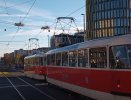Separate tram and trolleybus wires parallel to one another.Was watching a 'touristy' video on YouTube last night set in Zurich and noticed articulated trams and trolleybuses using the same street but wasn't looking closely enough to ascertain how they managed it.
Fun fact: like railway and tram catenary, trolleybus wires also have stagger (diagonal zig zags in the wire in the horizontal plane), as this helps to keep the trolley poles in contact with the wire.

